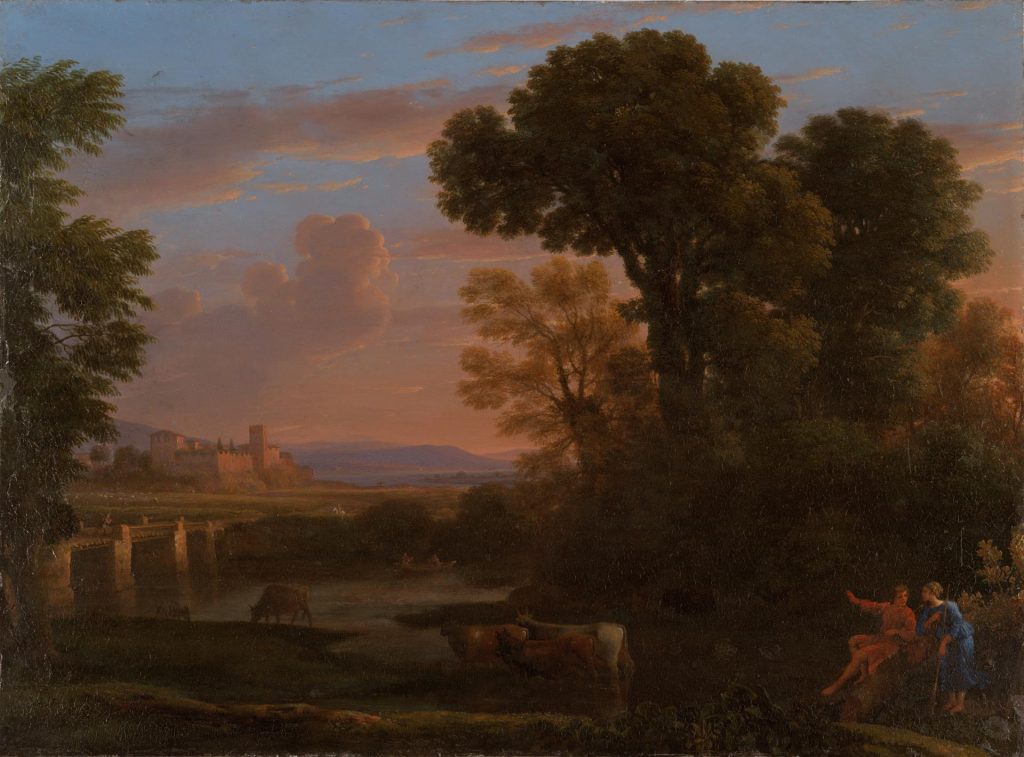French Painting
Nicolas Poussin
Although a Frenchman, Nicolas Poussin (1594-1665) had spent most of his life in Rome. He particularly admired the work of Raphael and, following Raphael’s example, advocated a classical approach to painting. A painting’s subject matter, he believed, should be drawn from Classical mythology or Christian tradition, not everyday life. There was no place in his theory of painting for a genre scene, even if portrayed on a monumental scale. Painting technique itself should be controlled and refined. There could be no loose brushwork, no “rough style.” Restraint and decorum had to govern all aspects of pictorial composition.

This poussiniste style is clearly evident in Et in Arcadia Ego of 1638-39. Three shepherds trace out the inscription on a tomb, Et in Arcadia ego, “I too once dwelled in Arcadia,” suggesting that death comes to us all. The Muse of History, standing to the right, affirms this message. Compared to the often-exaggerated physiques of figures in Rubens’ paintings, the muscular shepherds seem positively understated. Color, while sometimes brilliant, as in the yellow mantle robe of History, is muted by the evening light. But it is the compositional geometry of horizontals and verticals that is most typically poussiniste. Note how the arms of the two central figures form right angles and how they all fit within the cubical space suggested by the tomb itself. The cubic geometry finds its counterpoint in the way the lighted blue fold of History’s dress parallels both the red-draped shepherd’s lower leg and the leftmost shepherd’s staff. These lines suggest a diagonal parallelogram working both against and with the central cube.[1]
Claude Lorrain

When Claude Gellée (called “Claude Lorrain” or simply “Claude,” 1600-1682) went to Rome in 1613, he first studied with Agostino Tassi, an assistant of Guercino and a specialist in architectural painting. Claude, however, preferred landscape. He sketched outdoors for days at a time, then returned to his studio to compose his paintings. Claude was fascinated with light, and his works are often studies of the effect of the rising or setting sun on colors and the atmosphere. A favorite and much-imitated device was to place one or two large objects in the foreground – a tree, building, a figural group, or hill – past which the viewer’s eye enters the scene and proceeds, often by diagonal paths, into the distance.
Claude used this compositional device to great effect in paintings such as A Pastoral Landscape. Instead of balancing symmetrically placed elements in a statement of stable order, Claude leads his viewers actively into the painting in a continuing, zigzagging fashion. A conversing couple frames the composition at the right; their gestures and the ambling of the cows they are tending lead our attention toward the left on a slightly rising diagonal, where a bridge and the traveler moving across it establish a middle ground. Across the bridge into the distance is a city, setting up a contrast between the warm, soft contours of the pastoral right foreground and the misty angularity of the fortified walls and blocks composing the distant city. More distant still are the hazy outlines of hills that seem to take this space into infinity. The picture evokes a city dweller’s nostalgia and longing for the simpler and more sensuous life of the country.[2]
Georges de La Tour

Many French painters in the early seventeenth century were influenced by Caravaggio, although how they may have been exposed to the Italian artist’s style remains unclear. Most were minor artists working in the provinces, but a few developed highly original styles. The finest of these was Georges de La Tour (1592-1652), whose importance was recognized only in the nineteenth century. Although La Tour spent his career in Lorraine in northeast France, he was by no means a simple provincial artist. Besides being named a painter to King Louis XIII, he received important commissions from the governor of Lorraine. He began his career painting picturesque genre figures before turning to religious scenes that appealed to adherents of the Catholic faith, then the predominant religion in France. His use of light and his reliance on detailed naturalism derived largely from Caravaggio’s Northern European followers (like Hendrick ter Brugghen), whom he may have visited in the Dutch Republic.
La Tour’s mature religious pictures effectively convey the complex mysteries of the Christian faith. With its carefully observed details and seemingly humble subject, Joseph the Carpenter might initially be mistaken for a genre scene, but its devotional spirit soon overwhelms us. The two figures are set in profile, thus yielding little in their expressions. La Tour lends maximum significance to each gesture, each expression. The boy Jesus holds a candle, a favorite device of the artist, whose flame reinforces the devotional mood and imbues the scene with intimacy and tenderness. The painting has the power of Caravaggio’s Calling of St. Matthew, but the simplified forms, warm palette, and arrested movement are characteristic of La Tour’s restrained and focused vision.[3]
- Henry Sayre, The Humanities: Culture, Continuity and Change, vol. 2, 2nd ed. (Upper Saddle River, NJ: Pearson, 2015), 749-750. ↵
- Marilyn Stokstad, Art History, vol. 2, 4th ed, (Upper Saddle River, NJ: Prentice Hall: 2011), 764. ↵
- Penelope J.E. Davies, et. al. Janson’s History of Art: The Western Tradition, (Upper Saddle River, NJ: Pearson, 2007), 736. ↵

